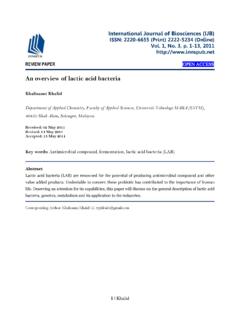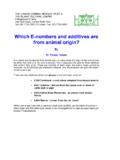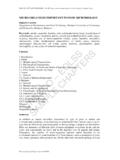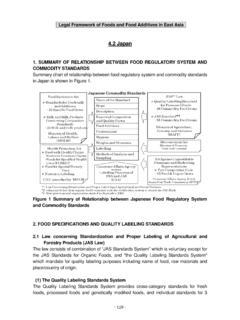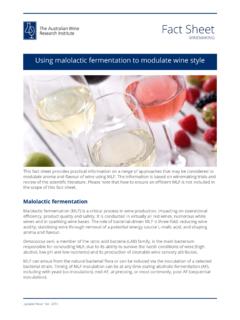Transcription of Surgical Sutures: An overview - jairjp.com
1 J. Acad. Indus. Res. Vol. 1(12) May 2013 778 Youth Education and Research Trust (YERT) Chellamani et al., 2013 ISSN: 2278-5213 Surgical Sutures: an overview Chellamani*, D. Veerasubramanian and Vignesh Balaji The South India Textile Research Association (SITRA), Coimbatore-641014, TN, India 0422-4215347 _____ Abstract Sutures are used to close the cuts caused by injuries or to close the incision due to surgery and other medical procedures like wound approximation.
2 They are commonly used on the skin, internal tissues, organs and blood vessels. They are available in the form of monofilament, multifilament/braided and pseudo monofilament. A lubricant is applied on the surface of braided suture material to lower the tissue drag and allow better knotability. They are also available in the form of either absorbable or non-absorbable sutures. Absorbable sutures undergo degradation and loss of tensile strength within 60 d whereas, the non-absorbable sutures retain tensile strength for longer than 60 d. The most important characteristics in biodegradation and absorption of absorbable sutures are the strength and mass loss profiles and the biocompatibility of degradation materials.
3 Synthetic absorbable sutures can be degraded by a hydrolytic mechanism via the scission of ester linkages in the polymeric backbone. This review focuses on suture and their classification in terms of suture manufacturing process. Further it is classified based on sutures absorption ability and the origin of raw material. Keywords: Sutures, incision, monofilament, multifilament, pseudo monofilament, hydrolytic process. Introduction Sutures have been used for at least 4000 years. Archeological records from ancient Egypt showed that Egyptians used linen and animal sinew to close wounds (Abdessalem et al., 2009). Sutures are the most frequently used biomaterial for wound closure and tissue approximation (Chellamani and Veerasubramanian, 2010).
4 They are used to close the cuts caused by injuries or to close the incision due to surgery and other medical procedures like wound approximation. They are commonly used on the skin, internal tissues, organs and blood vessels. There are two different kinds of sutures. One is absorbable sutures that will dissolve on their own. Another one is non-absorbable sutures that will be removed after certain period of time (Raul De Persia et al., 2005). The suture market currently exceeds $ billion annually. US Pharmacopoeia (USP), European Pharmacopoeia (EP) and British Pharmacopoeia (BP) are the official compendium for the suture industry, which sets standards and guidelines for suture manufacture.
5 suture sizes are given by a number representing diameter ranging in descending order from 10 to 1 and then 1 O to 12 O, 10 being the largest and 12 O being the smallest at a diameter than a human hair (Anand, 2006). Classification of suture Sutures can be broadly classified in to 3 groups based on their manufacturing process. They are i) Monofilament sutures, ii) Multifilament sutures and iii) pseudo monofilament sutures (Sabit Adanur, 1995; Sathish Bhalerao et al., 1998; Desai, 2005; Stashak and Theoret, 2008). The broad classification of the sutures is shown in Fig. 1. Monofilament A monofilament with its smooth surface can only be made from synthetic material by polymer extrusion method.
6 The important property of the monofilament is a minimal tissue reaction. This is because of monofilament smooth surface. Also the monofilament suture does not allow any bacteria to survive as compared to multifilament sutures. It is also easy to make or place a knot in the depth of the body. The main drawbacks of the monofilament are low knot security and less flexibility. Polyester, polyamide, polypropylene and polydioxanone are used as monofilament suture . Polyester has a high knot-pull tensile strength, good flexibility and low degradation. Polypropylene has excellent tissue drag and stability. Polydioxanone and polyglycolic acid-polycarbonate copolymer are dissolved gradually in body tissue by means of hydrolytic process.
7 The violet dyed monofilament suture is shown in Fig. 2. Fig. 2. Violet dyed monofilament suture (Chellamani et al., 2012). REVIEW ARTICLE J. Acad. Indus. Res. Vol. 1(12) May 2013 779 Youth Education and Research Trust (YERT) Chellamani et al., 2013 Multifilament/Braided suture Multifilament yarns can be twisted together to form a braided sutures. To form a braided suture , in general, eight to sixteen monofilament yarns are to be used. Obviously, due to the manufacturing method, the braided sutures have rough surface which causes tissue drag to be high.
8 A lubricant is applied on the surface of braided suture material to lower the tissue drag and allow better knotability. Braids are also flexible and easy to handle as compared to monofilament sutures. Polyesters, polyamides and silks are commonly used for manufacturing braided sutures. The suture in the form of a braid is shown in Fig. 3. Fig. 3. Braided suture (Chellamani et al., 2012). Pseudo-monofilament The pseudo-monofilament has a core of several twisted materials coated with an extrusion of the same material as the core. Fig. 4. Pseudo-monofilament (Chellamani et al., 2012). It has low tissue drag, good knotability and fair flexibility. It has drawbacks like low knot security as like mono filament sutures.
9 The structure of pseudo-monofilament is shown in Fig. 4. Absorbable and non-absorbable sutures Surgical sutures can be further classified in two groups. They are i) absorbable suture and ii) non-absorbable suture . Absorbable sutures: Absorbable sutures undergo degradation and loss of tensile strength within 60 d, either by enzymal degradation and subsequent hydrolytic or by hydrolytic alone (eg.: polyglycolic acid (Dexon)). The absorbable suture can be further classified in two groups. They are i) Natural and ii) Synthetic. Fig. 1. Classification of Surgical suture thread based on their manufacturing process. J. Acad. Indus. Res. Vol. 1(12) May 2013 780 Youth Education and Research Trust (YERT) Chellamani et al.
10 , 2013 Natural Catgut: Catgut the widely used suture is derived from animal intestines and is over 99% pure collagen. It is made from the submucosa of sheep intestines or the serosa of beef cattle intestines. It is monofilament and is absorbed by a process of enzymatic digestion. Absorption rate depends on size and also on whether the gut is plain or chromicised. The great advantage of catgut is that being absorbable it can be used even in the presence of infection. Tensile strength loss is faster than absorption. Collagen: It was evolved to overcome the disadvantages of conventional catgut. The flexor tendons of beefs were converted into dispersed fibrils. The dispersed fibrils were then extruded and reconstituted to form collagen sutures.
